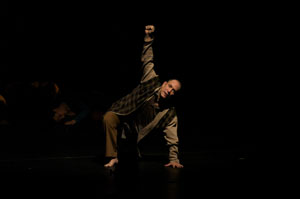7.) DANCE LITERACY Dance as a Language

David Dorfman’s belief that movement can have meaning and speak to vital political and social issues of our time is deeply indebted to these early modern dancers. His movement vocabulary, however, is not. Indeed, the combination of personal gesture, repetition of movements, pedestrian interludes (walking and directly talking to the audience), and athletic, full-body, rambunctious dancing is quintessentially post-modern, a style which developed in the 1980’s. After graduating from Connecticut College with and M.F.A. in dance, David Dorfman moved to New York City and danced with Susan Marshall’s company before starting his own in 1985. This was also the moment when AIDS-related illnesses were devastating the dance community. In 1987, Dorfman created a piece that intertwined his personal history of loss with that of the larger dance community.
While there are two people present throughout the dance, Sleep Story is essentially a solo which begins and ends with Dorfman running in place, talking. As he begins his story about visiting a Holocaust memorial in Eastern Europe, however, a tension is set up between his efforts to speak coherently and clearly enough to be understood by the audience and his breathing, which becomes increasingly audible as the dance progresses. To add to this bodily disruption, another dancer periodically slams into him, forcefully knocking him to the ground. This dancer crouches in the shadows next to him throughout the piece, unexpectedly interrupting his story mid-sentence by tackling him. At first, Dorfman agilely rolls back up to his feet after each attack, continuing the narrative exactly where he left off. Each blow brings in another bruising memory of absence, as his story weaves a tale of past cultural loss (the holocaust), with his own personal loss (Uncle Bob, his girlfriend) and the respective losses in his artistic and dance communities (of his ballet teacher Ernie Pagnano, Willie Smith). As his body becomes physically more distressed, his stories become more entangled with one another, as Dorfman tries to use the memory of the past to make sense of the present situation. Abruptly assaulted with each encounter with the past, however, he becomes physically and psychically overwhelmed with the experience of remembering loss. At the end of the dance, his narrative unwinds, his body becomes exhausted and yet running, still running, he marks the possibility of survival.
Classroom Activity: Exploring Gestures
Take a simple gesture of offering or receiving something. First do it in a normal, matter-of-fact manner. Then experiment with changing the dynamics, the speed, and the spatial extension (enlarging the gesture to include the whole body, for instance). Also experiment playing with repeating the gesture so that it starts to take on a meaning different from the original context of giving or receiving. Try the same exercise with a movement from sports, such as throwing a ball, or leaping a hurdle.

